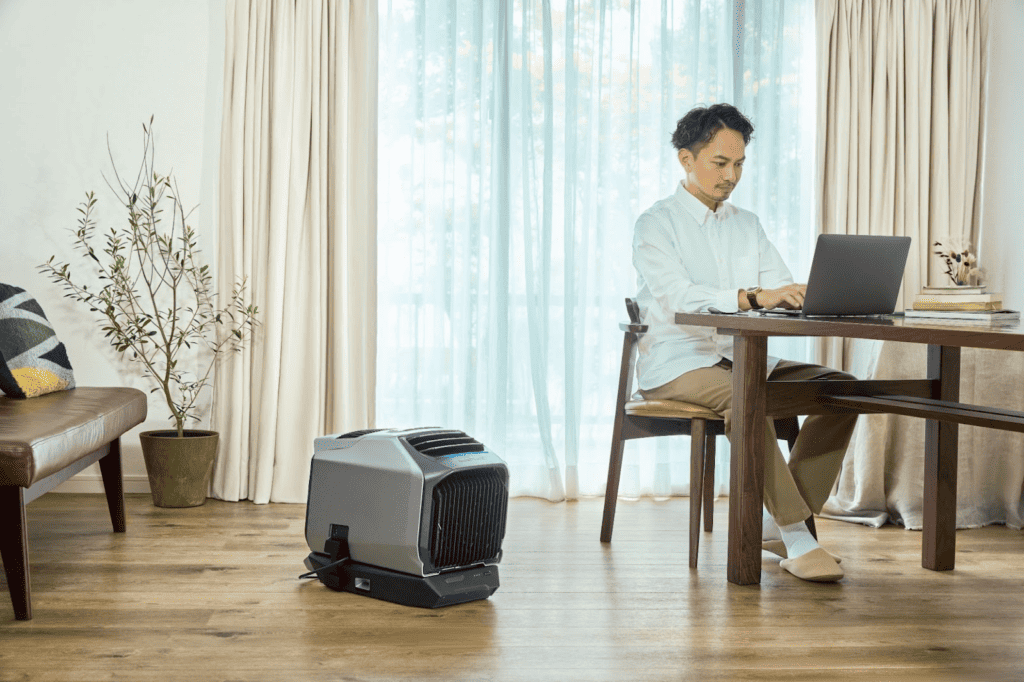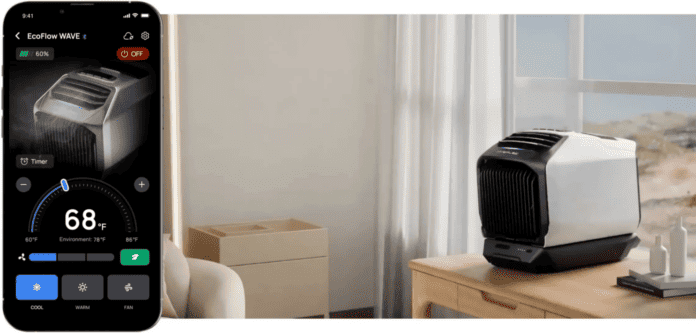Table of Contents
Depending on your living situation, you may not have access to a central HVAC system. Going without air conditioning can be uncomfortable and even dangerous in some climates.
If you live in an apartment or shared house, your options will likely come down to a portable air conditioner vs. a window AC unit.
While window ACs are the traditional option, recent improvements in portable AC technology have made them an increasingly popular alternative.
If you’re unsure which unit is best for your cooling needs, we’ve created a guide to help you compare the two options.
Let’s look at the pros and cons along with the key differences.

Portable Air Conditioners
A portable air conditioner is a freestanding appliance you can use anywhere in your home. It pulls in warm air, circulates it through the unit, then blows cold air from the vents.
Unlike a window AC unit, a portable AC is lightweight and compact. It runs on a battery or plugs into an AC (household) electrical outlet.

EcoFlow WAVE 2 offers 5100 BTUs of cooling and 6100 BTUs of heating power — it’s a portable HVAC system all-in-one!
Portable air conditioners like the EcoFlow WAVE 2, with an optional add-on battery, can recharge quickly in four different ways:
- AC (household) electricity
- Direct solar charging (with optional solar panels)
- DC car adapter AC
- Portable power stations
Pros
- No installation required
- Affordable
- Portable and easy to move from room to room
- Energy-efficient
- Multiple charging options for on and off-grid use
- Quiet
Cons
- Limited cooling capacity
- May not be suitable for cooling large spaces

Window AC Units
A window AC is a unit permanently mounted onto the window frame. It draws hot air from outside, circulates it through a refrigeration cycle, and blows cold air out.
Window ACs have a cooling capacity ranging from 5,000 to 12,500 BTUs. According to Consumer Reports, “a window AC needs 20 Btu for each square foot of living space” to cool effectively.
Unlike a portable air conditioner, window ACs units require semi-permanent installation. Window ACs are bulky and heavy — and can be dangerous to install. Many people leave them installed year-round.
While more energy-efficient than central AC, a window unit still consumes significant electricity, often doubling utility bills during the summer months.
Pros
- Powerful cooling capabilities
- More energy-efficient than central AC
- You can install multiple units in different rooms
Cons
- Bulky, heavy, and tricky to install
- Requires sufficient window space for installation
- Not portable
- Noisy due to fan motor
- Significantly adds to your electricity bill

What Are the Key Differences Between Portable Air Conditioners and Window Units?
Choosing the right air conditioner is crucial to getting through the stifling heat of summer in many locations — especially when you don’t have access to central air conditioning.
Here are the crucial factors to consider when making a purchase decision.
Installation
Portable air conditioners require no fixed installation. You can place the AC anywhere; most are compact enough not to take up too much space, even in small apartments.
Conversely, window AC units are a pain to install. They typically weigh upwards of 50 lbs (23 kgs) and as much as 130 lbs (60 kg).
And they’re bulky. You’ll most likely need help from a friend or HVAC professional for installation.
If you install an AC in your window, you can’t use it for other purposes. Most window ACs include accordion-style louvers to block fresh air from entering your home.
If you’re a tenant, you may need permission from your landlord before installation.
Performance
The performance of ACs and heaters depends on the number of British Thermal Units (BTUs), which measure cooling and heating capacity.
Generally, the higher the BTU rating of an AC, the more cooling power it has and the larger the space it can cool.
Higher BTUs also drive up the cost.
Window air conditioners have varying capacities, generally around 5,000-6,000 BTUs and up to 8,000-12,000 BTUs for larger units.
Portable air conditioners like the EcoFlow WAVE 2 offer comparable performance to small window ACs.
The EcoFlow WAVE 2 provides 5,100 BTUs of cooling power, enough to cool a 150 square ft (14 m2) room for up to eight hours of runtime in eco-mode.
Portability
Portable air conditioners are a more convenient alternative to bulky window AC units.
You can use them in various situations, from home cooling to camping, RV living, work sheds, and more. The EcoFlow WAVE 2 weighs about 31 lbs, making it the perfect cooling solution for camping off-grid.
Window AC units are not portable. Once installed, it’s not easy to move.
Power Source
Battery-operated models like the EcoFlow WAVE 2 take portability to another level.
You don’t even need access to an electrical outlet to use the device. With the EcoFlow DELTA 2 Portable Power Station w/220W solar panel, you can enjoy up to 7 hours of run time on the EcoFlow WAVE 2.
Or pair it with the EcoFlow DELTA Pro w/400W solar panel for up to 14 hours of cool.
You can also run a window AC unit by plugging it into a portable power station. However, unlike portable air conditioners, window units don’t have an internal battery and require an external power source.
Required Space
Window air conditioners are bulky. Once installed, the window’s mostly unsuitable for other uses.
If you take your window AC for the winter months, it will eat up substantial storage space.
On the other hand, portable AC models are compact. You can easily store them out of the way when not in use. And they don’t take up much space even while operating.

Noise
Window air conditioners have a motor-driven fan, which can become quite loud. You’ll have to look at the decibel (dB) rating on the model itself, but most are louder, ranging from 50 to over 80 dB.
Portable air conditioners are much quieter. Turn on Sleep Mode, and the EcoFlow WAVE 2 has a 44dB rating — about as loud as a refrigerator hum.
You can run it even at night and sleep peacefully (and in comfort).
Frequently Asked Questions
Which Is Better, a Window AC or a Portable AC?
Both window AC and portable air conditioners have their use cases. The right decision depends on your needs. Large window AC units have more cooling power than portable ACs. However, portable AC is more energy-efficient, quieter, and much easier to move around to multiple locations.

Final Thoughts
When box fans aren’t cutting it, you’ll need to upgrade to an AC.
Although window air conditioners can quickly cool a room, a portable air conditioner offers more convenience and quiet with exceptional performance.
The EcoFlow WAVE 2 is a versatile portable air conditioner that cools fast and saves money on electricity.
With multiple charging options — including solar panels — EcoFlow WAVE 2 can drop a room’s temperature by 18°F (8°C) in just 5 minutes. Unlike a window AC, which rarely offers heating, it can raise a room’s temperature by 18°F (8°C) just as quickly. Shop EcoFlow today for the 21st-century solution to energy-efficient cooling.
